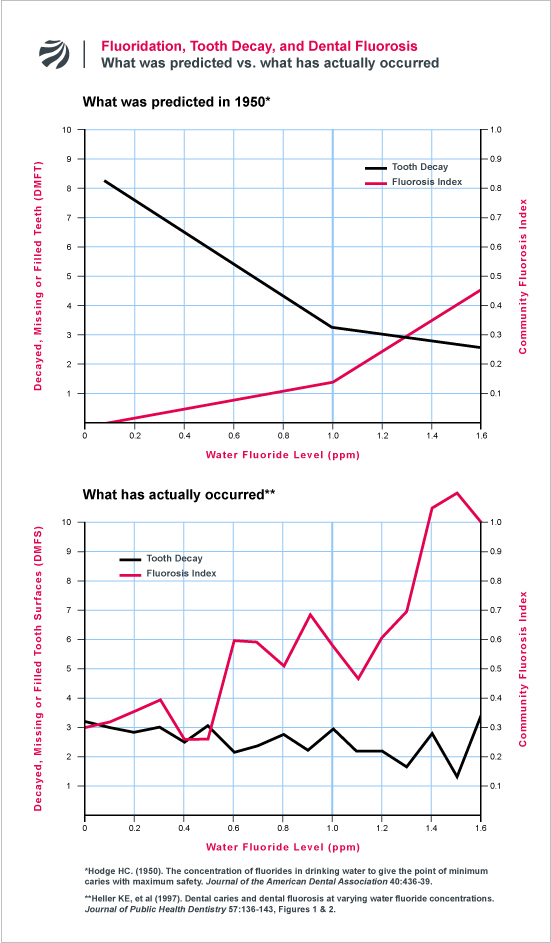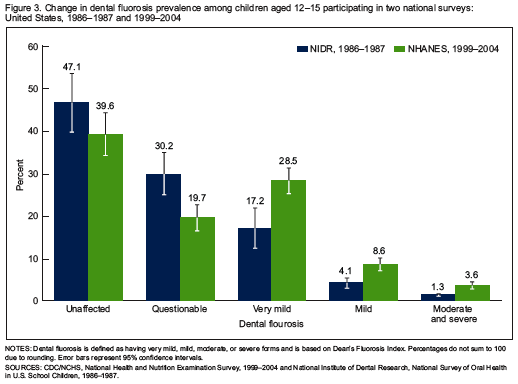The Community Fluorosis Index (CFI) is a way of measuring the burden of dental fluorosis in a population. Instead of just measuring the overall prevalence of fluorosis (i.e., what percentage of people have fluorosis), it takes into account the severity of the fluorosis that is occurring. The CFI is thus a measurement of both prevalence + severity.
As the calculation below demonstrates, the CFI among U.S. adolescents today is far higher than was predicted to be the case by U.S. health authorities in the 1950s. The latest national survey from the CDC shows that the CFI among 12-15 year olds (including those from both fluoridated and unfluoridated areas) is at least 0.66, which is almost 5 times higher than what U.S. health authorities predicted for children in fluoridated areas.
Before discussing the latest data from the CDC, we will start by explaining how to calculate a CFI score.
How the CFI Is Calculated
The CFI is calculated based on the following point scale for the different categories of dental fluorosis (using the Dean Index):
- Questionable Fluorosis = 0.5 points
- Very Mild Fluorosis = 1 point
- Mild Fluorosis = 2 points
- Moderate Fluorosis = 3 points
- Severe Fluorosis = 4 points
After determining how many children have these types of fluorosis, the points are added up and divided by the number of children examined. To understand how this calculation works, consider the following scenarios:
- Scenario A: One hundred children are examined, and 10 children are found to have dental fluorosis. Of these 10 children, all have “very mild” fluorosis. With 1 point assigned for each case of very mild fluorosis, the total fluorosis points would be 10. This is then divided by the number of children examined (n = 100) to produce the fluorosis index of 0.1.
- Scenario B: One hundred children are examined, and 10 children are found to have dental fluorosis. Of these 10 children, 5 have “very mild” fluorosis and 5 have “mild” fluorosis. Since 2 points are assigned for “mild” fluorosis, the total fluorosis points here would be 15 (= 10 points for the 5 mild cases + 5 points for the 5 very mild cases). When divided by the number of children examined, this produces a fluorosis index of 0.15.
The CFI that Was Predicted vs. the Actual CFI that Has Occurred
When water fluoridation was endorsed by the U.S. Public Health Service in 1950, it was believed that the community fluorosis index in areas with 1 ppm fluoride in water would be between 0.1 and 0.15. This would basically equate to about 7-8% of children having very mild fluorosis, and 2-3% of children having mild fluorosis. This prediction, however, has not proven true — a fact that is evident when contrasting it with the results of the National Institute of Dental Research’s 1986-87 national oral health survey. The following figure shows the difference:
The Current CFI in the United States
In 2010, the Centers for Disease Control published the results of a national survey of fluorosis that it conducted between 1999 and 2004. In the following figure, the CDC revealed that 19.7% of U.S. adolescents now have “questionable” fluorosis, 28.5% now have “very mild” fluorosis, 8.6% have “mild” fluorosis, and 3.6% have either moderate or severe fluorosis.
Although the failure to distinguish moderate from severe fluorosis makes it impossible to calculate the precise CFI from the CDC’s, we can determine the minimum CFI. Here is the calculation:
- 19.7% questionable fluorosis = 9.85 points
- 28.5% very mild fluorosis = 28.5 points
- 8.6% mild fluorosis = 17.2 points
- 3.6% moderate/severe fluorosis = > 10.8 points
- TOTAL POINTS = > 66.35 points
- COMMUNITY FLUOROSIS INDEX = > 0.66
Conclusion
The current Community Fluorosis Index (CFI) for adolescents in the United States (including those from both fluoridated and non-fluoridated areas) is roughly 5 times higher than what health authorities predicted for fluoridated areas when fluoridation first began. It is even higher than the CFI that the NIDR found in fluoridated areas back in the 1980s. This further confirms that children in the United States are ingesting far more fluoride than was the case in both the 1950s and 1980s.


